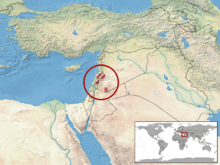Vipera bornmuelleri
| Vipera bornmuelleri | |
|---|---|
| | |
| Scientific classification | |
| Kingdom: | Animalia |
| Phylum: | Chordata |
| Subphylum: | Vertebrata |
| Class: | Reptilia |
| Order: | Squamata |
| Suborder: | Serpentes |
| Family: | Viperidae |
| Subfamily: | Viperinae |
| Genus: | Vipera |
| Species: | V. bornmuelleri |
| Binomial name | |
| Vipera bornmuelleri F. Werner, 1898 | |
 | |
| Synonyms | |
| |
- Common names: Bornmueller's viper.[3]
Vipera bornmuelleri is a venomous viper species[4] found in Lebanon, Jordan, Israel and Syria.[2] No subspecies are currently recognized.[4]
Etymology
The specific name, bornmuelleri, is in honor of German botanist Joseph Friedrich Nicolaus Bornmüller.[5]
Description
V. bornmuelleri grows to a maximum total length (body + tail) of about 75 cm (30 in), but usually much less. Males tend to be larger than females in some populations. In specimens from Mt. Lebanon, the maximum total lengths were 47.3 cm (18.6 in) for females and 53.8 cm (21.2 in) for males. The tail accounts for about 7-10% of the total length.[3]
Geographic range
It is found in high mountain areas in Lebanon and Syria.[1][6]
Taxonomy
The original syntypes were collected in Lebanon at 1800 m (5,900 ft) and in the Bolkar mountains of western Turkey at 2200 m (7,200 ft) as described by Franz Werner in 1898.[7][8] In 1922, Werner restricted the type locality to Lebanon in his designation of his specimen as a lectotype,[9] and in 1938 separated out the southern varieties as a separate species (Vipera palaestinae).[10] In 1967 Mertens raised the name bornmuelleri to valid species rank for the Lebanese populations,[11] thus leaving the name xanthina for all Turkish populations, which arrangement was accepted by Baran in 1976,[12] and agreed with by Nilson and Andrén in their 1985 paper.[1][8]
Conservation status
This species is classified as Endangered (EN) according to the IUCN Red List of Threatened Species with the following criteria: B1ab(iii) (v3.1, 2001).[6] This indicates that it is facing a high risk of extinction in the wild because the extent of its occurrence within its geographic range is estimated to be less than 20,000 km², because its populations are severely fragmented or known to exist at no more than 10 locations, and because a continued decline is observed, inferred or projected in the area, extent and/or quality of its habitat.[13]
Listed as such because its extent of occurrence is less than 5,000 km², its distribution is severely fragmented, and there is a continuing decline in the extent and quality of its mountain habitat due to overgrazing. Year assessed: 2005.[6]
See also
- List of viperine species and subspecies
- Viperinae by common name
- Viperinae by taxonomic synonyms
- Snakebite
References
- 1 2 3 McDiarmid RW, Campbell JA, Touré T. 1999. Snake Species of the World: A Taxonomic and Geographic Reference, Volume 1. Washington, District of Columbia: Herpetologists' League. 511 pp. ISBN 1-893777-00-6 (series). ISBN 1-893777-01-4 (volume).
- 1 2 The Reptile Database. www.reptile-database.org.
- 1 2 Mallow D, Ludwig D, Nilson G. 2003. True Vipers: Natural History and Toxinology of Old World Vipers. Malabar, Florida: Krieger Publishing Company. 359 pp. ISBN 0-89464-877-2.
- 1 2 "Vipera bornmuelleri". Integrated Taxonomic Information System. Retrieved 16 August 2006.
- ↑ Beolens, Bo; Michael Watkins; Michael Grayson. 2011. The Eponym Dictionary of Reptiles. Baltimore: Johns Hopkins University Press. xiii + 312 pp. ISBN 978-1-4214-0135-5. (Vipera bornmuelleri, p. 32.)
- 1 2 3 Montivipera bornmuelleri at the IUCN Red List. Accessed 2 September 2007.
- ↑ Werner, F. 1898. Über einige neue Reptilien und einen neuen Frosch aus dem cilicischen Taurus. Zoologischer Anzeiger 21: 217-223.
- 1 2 Nilson, Goran, and Claes Andrén. 1985. Systematics of the Vipera xanthina Complex (Reptilia: Viperidae). III. Taxonomic Status of the Bulgar Dagh Viper in South Turkey. Journal of Herpetology 19 (2): 276-283. (p. 276.)
- ↑ Werner, F. 1922. Synopsis der Schlangenfamilien der Amblycephalidae und Viperida. Archiv für Naturgeschichte 8A: 185-244.
- ↑ Werner, F. 1938. Eine verkannte Vipera (Vipera palaestinae n. sp.). Zoologischer Anzeiger 122: 313-318.
- ↑ Mertens, R. 1967. Über Lachesis libanotica und den Status von Vipera bornmuelleri. Senckenbergiana Biologica 48 (3): 153-159.
- ↑ Baran, İ. 1976. Tiirkiye yilanlarinin taksonomik revizyonu ve cografi dagilislari. TBTAK Yayinlari, Ankara, T.B.A.G. Series 9, (309): 177.
- ↑ 2001 Categories & Criteria (version 3.1) at the IUCN Red List. Accessed 2 September 2007.
Further reading
- Garrigues T, Dauga C, Ferquel E, Choumet V, Failloux A-B. 2005. Molecular phylogeny of Vipera Laurenti, 1768 and the related genera Microvipera (Reuss, 1927) and Daboia (Gray, 1842), with comments about neurotoxic Vipera aspis aspis populations. Molecular Phylogenetics and Evolution 35 (1): 35-47.
- Golay P, Smith HM, Broadley DG, Dixon JR, McCarthy CJ, Rage C-J, Schätti B, Toriba M. 1993. Endoglyphs and other Major Venomous Snakes of the World. A Checklist. Geneva: Azemiops. 478 pp.
- Obst FJ. 1983. Zur Kenntnis der Schlangengattung Vipera. Zool. Abh. staatl. Mus. Tierkunde Dresden 38: 229-235.
External links
- Montivipera bornmuelleri at the Reptarium.cz Reptile Database. Accessed 21 October 2013.
